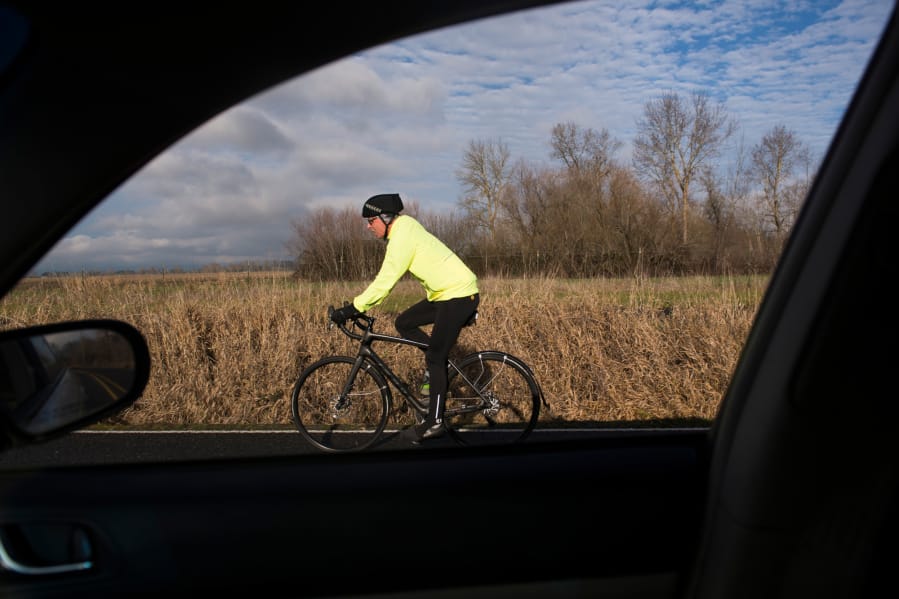As of the new year, Washington cyclists and pedestrians should be enjoying a less-crowded, less-vulnerable feeling when forced to share public roadways with motor vehicles. A new state law that took effect Jan. 1 mandates that motorists passing cyclists or pedestrians in the road must give them at least 3 feet of space, if not a whole lane. At least 35 other states already had such a requirement.
A recent “Three Feet Please” ride organized by the Vancouver Bicycle Club aimed to raise public awareness of the new law, which intends to protect “vulnerable roadway users” by cracking down on drivers leaving whisker-thin buffers as they blast past bikes and walkers who have no sidewalks and no bike lanes — nowhere to travel but along the same pavement.
Terrifyingly close shaves are terribly routine for cyclists who have every right to share local roadways with cars, club members said.
“I felt the wind of this minivan mirror go past my elbow by inches” during a ride in the country north of Battle Ground, recalled club president Devin Bowen. “It was so close, it really scared me. I don’t think it was intentional.” He’s not sure that driver even saw he was there, he said.
Other times, he added, dangerously close drivers must have seen him sharing the lane — and must have found it awfully irritating.
“I’ve had cars swerve at me,” he said. “I doubt they were intending to hit me, but I do think they were saying, ‘Look, I’m in charge on the road and I really don’t like you being here.’ ” The result is even greater danger for cyclists and pedestrians.
The League of American Bicyclists has named Washington the bike-friendliest state 10 times in a row, but according to an October 2019 report by the Washington Traffic Safety Commission, pedestrian and cyclist deaths here shot up 41.2 percent (from 233 to 329) between 2015 and 2017. During the same period, serious injuries to pedestrians and cyclists rose 11.1 percent, from 1,165 to 1,333.
Motorists enjoy a complete, connected network of pavement while pedestrians and bikes don’t, the report points out. Installing dedicated bike lanes and sidewalks that are physically buffered from roadways would be a major step toward safety, it says, but that’s a slow and costly process. Meanwhile, last year’s state Legislature and Gov. Jay Inslee adopted another chief safety recommendation from the commission.
Give a lane
The new law sharpens a previous, rarely enforced 2012 version by detailing how drivers must pass “vulnerable roadway users” — defined as pedestrians and people riding in the roadway (not sidewalks or bike lanes) on bikes, e-bikes, motorcycles, assistive personal mobility devices, motorized scooters, non-enclosed farm machinery and animals. It also adds enforcement teeth and hikes fines.
The previous law simply said that traffic overtaking and passing other roadway traffic must do so “at a safe distance,” which was vague enough to be unenforceable, according to Washington Bikes, a political advocacy group that lobbies for the growth and safety of cycling. The new law adds the specifics:
• Two lanes? Give one. When two or more lanes are traveling in the same direction, the driver must move over completely, at least one whole lane to the left, to pass the vulnerable user.
• One lane? Give 3 feet. When it’s just one travel lane, the passing driver must slow down and give the vulnerable user at least 3 feet of space.
• One lane, with space on the opposite side? Move all the way over. When it’s safe to do so, the passing driver must move all the way into the opposite-direction lane, providing a whole lane of space for the vulnerable user.
The law also adds a little wiggle room for bikes on the right. It specifies that bikes should avoid blocking faster traffic by staying as far right as possible — except “when reasonably necessary to avoid unsafe conditions.” Roadway edges can be obstacle courses of gravel, trash, broken glass and storm drains. Bikes may legally avoid all that by occupying the main travel lane when they must.
“There’s often debris over to the right,” said Bowen. “There are times you need to get into the travel lane for your own safety.”
The law also clarifies that a cyclist approaching an intersection can continue straight even when riding in a right-turn-only lane. And it doubles the fines for infractions, with the extra dollars going into a special education account promoting awareness of the new law. The 2012 version was rarely enforced because of a lack of awareness, according to the commission.
Enforcement practices
Even with new specifics and increased penalties, how likely is it that the updated law — governing roadway encounters that last mere moments — gets enforced more than the previous one?
Hard to say, Vancouver Bicycle Club members agreed. Club publicist Donna Richardson said she’s called the Clark County Sheriff’s Office with license plate numbers of vehicles with drivers who “road raged” at her, and was told the office was too busy to look into that.
Many serious cyclists have started wearing GoPro video cameras to catch aggressive drivers in the act. Richardson assumes their footage will get taken a lot more seriously in the new year, she said.
“Bicycling is becoming more popular,” Richardson said. “But if it’s seen as really unsafe, that’s going to dissuade people. Our club’s number one priority is safety.”
Club member Dick Gordon wants to keep taking the new law’s message directly to motorists. He wants the club to print up yellow cyclist jerseys reading “Three Feet Please” in big, bold letters that drivers just can’t miss.
“I’m happy to wear a billboard on my back,” Gordon said. “How else are we going to get the word out?”




